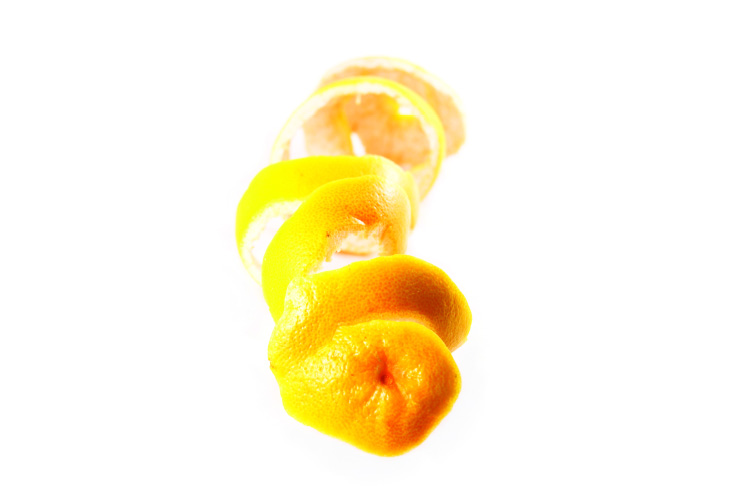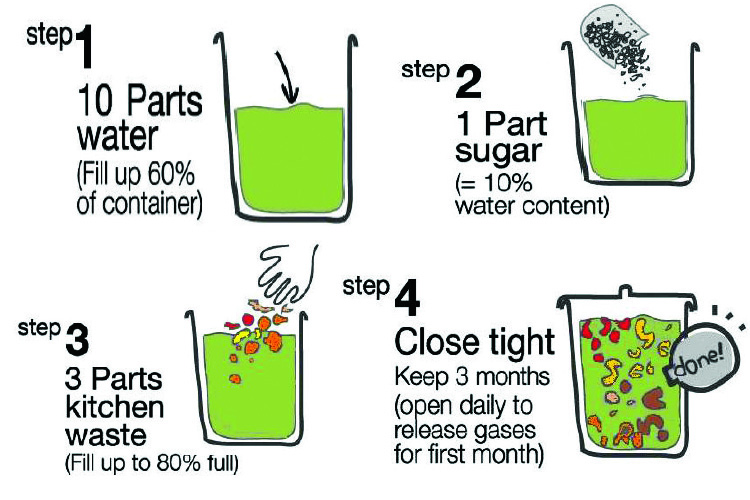This may come as a surprise, but did you know your garbage waste can actually reduce global warming? What hogwash! Well, can’t blame you. We’ve been warned that garbage is hazardous and poses great risks to the environment if improperly disposed, which of course is a valid point. Next time, rather than throwing away fruits and vegetable scraps, put them to better use to protect the environment by making an enzyme out of them.
Table of Contents
What is garbage enzyme?
Garbage enzyme (also known as Eco Enzyme) is a complex solution produced by fermentation of fresh kitchen waste (fruit and vegetable dregs), sugar (brown sugar, jaggery or molasses sugar) and water. It is dark brown and has a strong sweet sour fermented scent. This fermentation creates a vinegar-like liquid with natural proteins, mineral salts and enzymes that make it multipurpose. Garbage Enzyme is a non-toxic, anti-bacterial cleanser, air purifier, deodoriser, insecticide, organic fertiliser, drain cleaner, car cleaner and more. It has uses in home and office, and even outdoors in gardens and farming.
Who discovered garbage enzyme?
Eco enzyme was developed by Dr. Rosukon Poompanvong from Thailand. Dr. Rosukon has been actively involved in enzyme research for more than 30 years and she encourages people to make eco enzyme at home to ease global warming. She started to teach farmers around the country on ways to produce healthy food with her enzyme method since 1991.
Why should you make garbage enzyme?
Each time you use cleaning products made with chemicals, you are already polluting the underground water, rivers and the surrounding eco-system. Conventional cleaning products usually contain harmful chemicals such as phosphate, nitrates, ammonia, chlorine etc. The accumulation effect of these chemicals released from every household can cause significant damage to Mother Earth.
Characteristics of Eco Enzyme
Eco Enzyme is easy to make and multifunctional. Its main ingredients are brown sugar, water and food waste. After fermentation, the brown-coloured liquid will smell like orange. As unwanted materials are reused, we can reduce waste signifcantly by making Eco Enzyme. When the Eco Enzyme is fermenting, ozone (O3) emitted from it can separate carbon dioxide and other heavy metals from the air. As a result, heat trapped in the atmosphere will be reduced. Eco Enzyme can also turn ammonia into nitrate (NO3), which is a fertiliser. It can also transform carbon dioxide into CO3, which can nourish plants, fsh and other living things in the ocean.
- Decompose, transform and recombine different materials.
- If enzymes (e.g. Photosynthesis bacteria) are not exposed to the air, they can remain active even at the temperature as high as 100°C.
- If eco enzyme is full of its necessary nutrients, it can still survive even at pH value below 3.5.
- It can produce antioxidants, which decelerate the ageing of cells.
Making eco enzyme
Container: Air-tight plastic container.
Ingredients: Water, fruits and vegetable dregs, sugar (brown sugar, molasses sugar).
Instruction:
1. Prepare an air-tight plastic container.
2. Dilute sugar in water, follow by adding fruit and vegetable dregs (does not contain of paper, plastic, metal and glass. Avoid oily cooked food, fish or meat).
3. Leave some air space for fermentation.
4. Make sure the container is air-tight.
5. During the first month, gases will be released during fermentation process. Release the pressure built up in the container to avoid rupturing.
6. Push the floating dregs downward every once in a while.
7. Place at cool, dry and well ventilated area. Avoid direct sunlight. Let ferment for at least 3 months before use. Filter and it is ready to use.
8. After 3 months, extract out the water and leave only the sediment. The sediment can be dried to become fertiliser or may leave it for next fermentation.
9. The ideal colour of eco enzyme is dark brown. If the colour turns to black, add same amount of brown sugar to re-ferment it.
10. It may have white, black or brown layer on top of the eco enzyme, ignore it. If you encounter worms in the container, leave it for a while, then close the cover tightly.
11. If you have not gathered enough kitchen waste, you may fill up the container gradually. The 3 months fermentation period start from the last day you add in the kitchen waste.
Going Green with ecoenzyme
Let eco-enzyme be your best household helper – general cleaner, air purifier, insect repellent, laundry cleaner, car care, organic fertiliser, and more. It is easy to DIY at negligible cost, free of harmful pollutants, effective, with multipurpose environment-friendly usage. It is economical, useful and beneficial to our health and the earth. Here are some of them:
House cleaning
Diluted eco enzyme can be used to eliminate odour, mold, dirt and oil stain. It is also effective for cleaning floor, air conditioners, toilets, exhaust fans etc. In addition, pests such as flies, mosquitoes, rats and cockroaches will become fewer if we use eco enzyme to clean our houses.
Keeping personal hygiene
Eco Enzyme can decompose and eliminate microorganisms that are harmful to us. We can up keep our personal hygiene by using eco enzyme to take bath, wash hair and do laundry.
Keeping healthy pets
Remove pets’ odour and parasites on them.
Wash vegetables and fruits
Soaking vegetables and fruits in diluted eco enzyme (2 teaspoons of eco enzyme and 1 litre of water) for 45 minutes can remove pesticides, herbicides, chemicals, heavy metals, bacteria and parasitic ova on them. They will taste better after being soaked.
Discover the miracle of eco-enzyme.
Care for the earth, starting from your kitchen.
For more information visit www.enzymesos.com

















